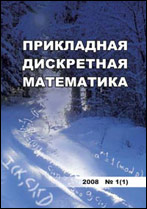|
Theoretical Backgrounds of Applied Discrete Mathematics
Analysis of minimal distance of AG-code associated with maximal curve of genus three
E. S. Malygina, A. A. Kuninets
Immanuel Kant Baltic Federal University, Kaliningrad, Russia
Abstract:
We consider a class of algebraic geometry codes associated with a maximal curve of genus three whose number of rational points satisfies the upper Hasse — Weil — Serre bound. It is proved that the number of rational points of such curve is odd and has a classification: the first type includes $4$-tuples of conjugate points of multiplicity $1$, the second type includes couples conjugate points of multiplicity $2$, and the third type includes a single point of multiplicity $4$. It is found out for which types of points the divisor of the functional field of the desired curve and consisting of these points is the principle. We consider special cases when $\mathrm{deg}\,(G)=2,4$, and establish the form of a divisor $D$ when AG-code $\mathcal{C}_{\mathscr{L}}(D,G)$ associated with the divisors $D$ and $G$ is MDS-code. It is shown that the AG-code $\mathcal{C}_{\mathscr{L}}(D,G)$ is not an MDS-code if the divisor $D - G$ is principle and $\mathrm{deg}\,(G) \geq 5$. Also, it is proved that $\mathcal{C}_{\mathscr{L}}(D,G)$ is an MDS-code if the divisor $D$ consists only of the first type points of curve conjugated to each other for $\mathrm{deg}\,(D) \geq 8$ and $G=\dfrac{\mathrm{deg}\,(D)+2}{2}P_\infty$. Finally, it is shown that the dual equivalent code $\mathcal{C}_{\mathscr{L}}(D,H)^\perp$ to the code $\mathcal{C}_{\mathscr{L}}(D,G)$, which is not MDS, will also not be MDS with conditions $\mathrm{deg}\,(D)-\alpha < \mathrm{deg}\,(H) < \mathrm{deg}\,(D)$, $4 < \mathrm{deg}\,(G) < \alpha+4$, $5<\alpha<\mathrm{deg}\,(D)-5$, and $D$ consists only of conjugate points of the first type.
Keywords:
algebraic geometry code, minimal distance, mds-code, maximal curves, function field, divisor.
Citation:
E. S. Malygina, A. A. Kuninets, “Analysis of minimal distance of AG-code associated with maximal curve of genus three”, Prikl. Diskr. Mat., 2022, no. 58, 5–14
Linking options:
https://www.mathnet.ru/eng/pdm780 https://www.mathnet.ru/eng/pdm/y2022/i4/p5
|

| Statistics & downloads: |
| Abstract page: | 113 | | Full-text PDF : | 50 | | References: | 25 |
|




 Contact us:
Contact us: Terms of Use
Terms of Use
 Registration to the website
Registration to the website Logotypes
Logotypes







 Citation in format
Citation in format 